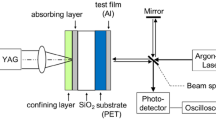Abstract
Lamination is a method utilized to protect flexible electroluminescence device against environmental hazards, such as dust, moisture, and water vapor. The materials are typically joined together using adhesive or cohesion of the materials during the lamination process. Polyethylene terephthalate (PET) is commonly used as the substrate film where electroluminescence patterns are printed. However, PET film has a relatively low surface energy and high contact angle, which would cause relatively weak laminating strength. This paper discusses the use of atmospheric plasma as a surface treatment method to modify PET and laminating films’ interface to improve bonding and laminating quality. Experimental results revealed that atmospheric plasma process reduced the contact angle of both PET and laminating films. Functional groups favoring hydrophilicity were found on the films’ interface after the atmospheric plasma treatment. These effects consequently increased surface energies of both films and favored bonding between the films. The treated films thus had increased laminating strength by approximately six times without compromising the transparency quality.





Similar content being viewed by others
References
Hernandez RJ (1997) Food packaging materials, barrier properties, and selection. In: Valentas KJ, Rotstein E, Singh RP (eds) Handbook of food engineering practice. CRC Press, New York, pp. pp 291–pp 360
Pocius AV (2002) Adhesion and adhesives technology—an introduction, 2nd edn. Hanser, Munich
Rouxhet PG (2013) Contact angles and surface energy of solids: relevance and limitations. In: Mittal KL (ed) Advances in contact angle, wettability and adhesion. Scrivener Publishing, Salem, pp. 349–375
Kinloch AJ (1990) Adhesion and adhesives—science and technology. Chapman and Hall, London
Ma K-X, Ho C-H, Zhu F, Chung T-S (2000) Investigation of surface energy for organic light emitting polymers and indium tin oxide. Thin Solid Films 371:140–147
Sharpe LH, Schonhorn H (1964) Surface energetics, adhesion, and adhesive joints. In: Fowkes FM (ed) Contact angle, wettability, and adhesion, vol 43. Advances in Chemistry. American Chemical Society, Washington, pp. 189–201
Yang L, Chen J, Guo Y, Zhang Z (2009) Surface modification of a biomedical polyethylene terephthalate (PET) by air plasma. Appl Surf Sci 255:4446–4451
Tendero C, Tixier C, Tristant P, Desmaison J, Leprince P (2006) Atmospheric pressure plasmas: a review. Spectrochim Acta Part B: Atomic Spectrosc 61(1):2–30. doi:10.1016/j.sab.2005.10.003
ASTM (1995) D1876-95 standard test method for peel resistance of adhesives (T-peel test). ASTM International, West Conshohocken
Nishikida K, Coates J (2003) Infrared and Raman analysis of polymers. In: Lobo H, Bonilla JW (eds) Handbook of plastics analysis. Marcel Dekker, New York, pp. 186–316
Infra-red Spectra for LDPE and HDPE. http://www.catalysis-ed.org.uk/polyethene/poly_3_popup.htm. Accessed 9 June 2015
Kinzy S, Falcone R (2003) Thermogravimetric analysis of polymers. In: Lobo H, Bonilla JW (eds) Handbook of plastics analysis. Marcel Dekker, New York, pp. pp 100–pp 118
Shi XM, Zhang J, Jin J, Chen SJ (2008) Non-isothermal crystallization and melting of ethylene-vinyl acetate copolymers with different vinyl acetate contents. Express Polym Lett 2(9):623–629
Gomathi N, Chanda AK, Neogi S (2013) Atmospheric plasma treatment of polymers for biomedical applications. In: Thomas M, Mittal KL (eds) Atmospheric pressure plasma treatment of polymers—relevance to adhesion. Scrivener Publishing, Salem, Massachusetts
Svirachev DM, Tabaliov NA (2005) Plasma treatment of polymer surfaces in different gases. Bulg J Phys 32:22–33
Author information
Authors and Affiliations
Corresponding author
Rights and permissions
About this article
Cite this article
Wiria, F.E., Tham, C.L., Subramanian, A.S. et al. Improving surface quality of polyethylene terephthalate film for large area flexible electronic applications. J Solid State Electrochem 20, 1895–1902 (2016). https://doi.org/10.1007/s10008-015-3021-6
Received:
Revised:
Accepted:
Published:
Issue Date:
DOI: https://doi.org/10.1007/s10008-015-3021-6




